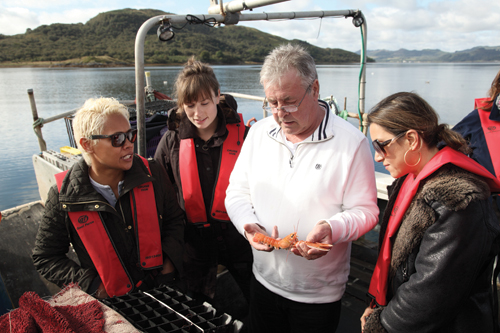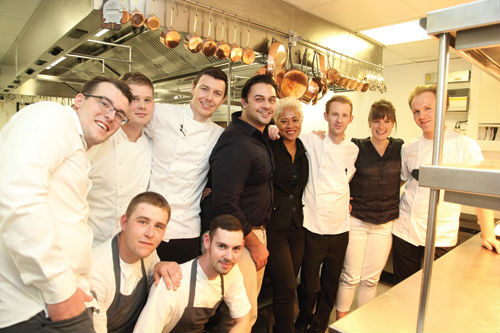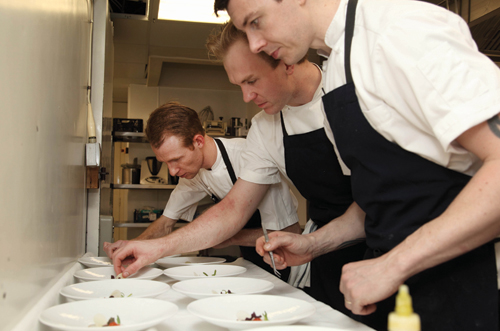Creel fishing: a sustainable sourcing method
Janie Manzoori-Stamford reports
On a grey drizzly September day in London, chefs Monica Galetti, Renee Miller, Dhruv Baker, Arran Seymour and The Caterer board a short flight to Glasgow. The point of the trip: to learn about creel fishing.
Upon arrival at Glasgow airport, our hosts from Seafood Scotland greet and travel with us to Cameron House hotel and resort on the banks of Loch Lomond, our home for the night.
Here we enjoy stunning scenery, incredible weather and a superb dinner at restaurant Martin Wishart, in the company of Alistair Sinclair and James Cook, chair and treasurer of the Scottish Creel Fishermen's Federation (SCFF) respectively, and James Withers, chief executive of Scotland Food & Drink, as well as Natalie Bell from Seafood Scotland.
Following breakfast the next day, we hop back on the minibus for the drive to Loch Fyne, where we once again meet up with Sinclair for our creel fishing trip on the Wicked Wendy. Blessed again by outstanding, picture-postcard weather, the chefs are able to focus their attentions on learning the intricacies of creel fishing from Sinclair. If there's anything he doesn't know on the subject, it's clear that it's not worth knowing.
For instance, we learn that a staggering 75% of creel-caught hauls are exported to Europe at present, with just 25% staying in the UK and going into restaurants.
Given the quality of the product that is sourced using the creel fishing method, it's unsurprising that the SCFF would like to see the UK take much more of the catch.
"We've not even cracked the ice where the home market is concerned and that's why we really want to get a community supported fishery scheme up and running," explains Sinclair. "It doesn't have to be the community immediately adjacent to the fishery. Dhruv [Baker] and I talked about the possibility of getting a packed van down to London once or twice a week.
"The beauty of that is you know it's just come off the boat. By the time it gets there it's still less than 12 hours old. That's completely different if you go through the supply chain."
It's not just the freshness of the product that the London market would benefit from, but the quality that is maintained through the fishing process. Sinclair tells the chefs about the effect that trawler-induced stress has on langoustine and prawns: "Once a prawn has been through a trawl and it's been hauled in and beaten about on the seabed, they get all stressed out and release an enzyme that causes the sugar level to drop. The way we do it is as natural as it comes."
The process to which he is referring involves pulling up the creels one at a time and sorting through their contents by hand. Langoustines of the right size are stashed in a divided-up box - or 'tubes', as they are known - and by-catch, egg-bearing 'berried' females and undersized creatures are carefully returned to the water.
"The prawns are put into the tubes so they are not all sitting together, knocking hell out of each other like a pub full of Scotsmen on a Friday night," Sinclair jokes.
According to the chefs, the fishing trip was an eye-opener. Former Le Gavroche chef Galetti says that by learning about the industry, chefs are better able to support it, and Baker - past MasterChef winner and part owner of the Ealsfield Kitchen and Jolly Gardeners Earlsfield - agrees: "It makes you think differently about the product when it comes into the kitchen, after you've seen the way it's caught like this."
It was very apparent to all the chefs on board the Wicked Wendy that the passion and care that goes into creel fishing is vast. The men we watched pull up the creels - helped by Galetti, who couldn't wait to get stuck in - were incredibly knowledgeable about their industry and performed their tasks with care and pride.
"The time we were able to spend speaking with the fisherman was great," says Miller, who was most recently sous chef at two-Michelin-starred Le Gavroche.
"We learned how important it is to become involved and be responsible for making the right choices to help creel fishing have a better future, and not just because the product caught in creels is much better. The next step is to make sure the chefs that are cooking them in our restaurants are aware of where they came from, and to be sure that the product is respected."
Seymour, sous chef at Gordon Ramsay's Maze restaurant in London's Mayfair, shares Miller's view: "I think all chefs need to understand their products a bit more. It's something we all take a bit for granted and just haggle the price down.
"Speaking to a supplier or grower to understand your produce is as important as adding salt when cooking. It was incredible to watch the guys working on their boats in such a beautiful environment, for something as simple as a langoustine; to see the care they take with each individual animal, and that no stress was involved. We can all learn more; it's just whether or not a chef wants to."
Creel fishing
Creel fishing, also known as potting, involves baited creels dropped from the boat to the seabed where they 'soak' - capture their catch - until they are retrieved by the vessel. This is usually 24 hours later, but depends greatly on weather conditions. The creel fishermen keep a watchful eye on the weather forecast and if it looks like a creel will have to soak for longer, they increase the amount of bait used in order for it to keep on fishing.
The creel itself is generally made of plastic-coated round steel bars and covered with netting. The target species, which in Scotland are usually prawns, langoustines, lobsters and crabs, enter via a small netted tunnel on either side of the creel. The bait used is herring.
Creel fishing is a profitable and environmentally sustainable form of fishing with very little by-catch. Target species are brought to the surface alive and undamaged, meaning that egg-bearing 'berried' females or undersized specimens can be returned to the sea. The carbon footprint, in particular fuel consumption, is minimal compared to other methods of fishing, as the majority of the boats are small - usually under 10 metres in length - and fish relatively close to shore.
There are usually 50 creels on each 'string', which is marked in the water with a float. A creel boat fishing for langoustine pulls up an average haul of around 50 kilos (from about 800 creels) a day, which has a value of anything between £500 and £1,000. The fishermen are usually out for 10 to 12 hours a day.
Restaurant Martin Wishart
Housed within the five-AA-star, 125-bedroom Cameron House hotel and resort on Loch Lomond, Martin Wishart is a Michelin starred, four-AA-rosette fine-dining restaurant with Graeme Cheevers at the helm as head chef.
Eight-course tasting menu
- Brown crab and avocado, black garlic and tomato
- Langoustine tartare, Granny Smith apple, coriander, keta and crème fraiche
- Roasted lobster, brown shrimps, verjus and parsnip purée
- Orkney scallop 'beurre noisette', caramelised cauliflower and sea vegetables
- Fillet of organic salmon, citrus-braised endive and Champagne and caviar sauce
- Goosnargh duck breast, mushroom purée, yellow corn and girolles
- Saddle of lamb, goats' cheese, aubergine and caramelised onion jus
- Valrhona dark chocolate and passion fruit délice, kaffir lime leaf ice-cream
Samphire, Inverary
Located in the historic fishing town of Inverary on the banks of the Loch Fyne, chef-proprietor Andrew MacLugash's Samphire is a seafood restaurant that uses locally sourced and sustainable seafood and shellfish, along with meat and game from the surrounding hills and glens.
Sample dishes
Starters
- Smoked haddock Cullen skink, potato, bacon and crisp leeks
- Seared breast of wood pigeon, Stornoway black pudding, beetroot and crème fraiche, red wine jus
Mains
- A 'taste of the loch': grilled half lobster, langoustines, brown crab claws and razor clams, steamed cockles, surf clams and mussels, garlic and parsley butter, dressed salad
- Pan-fried fillet of Gigha halibut, Isle of Mull mussels, lightly spiced chilli, broad bean and parsley butter sauce, samphire
Desserts
- Warm lemon tart, crème chantilly, raspberry coulis
- Dark chocolate and orange torte, chocolate brownie, burnt orange sauce
- Kilbrannan langoustine ceviche, Granny Smith apple and crème fraÁ®che
Serves 4
- 8 langoustines
- 20ml olive oil
- 1 Granny Smith apple
- 100g mooli (white radish)
- 50g crème fraÁ®che
- 8 borage leaves
- 40g salmon keta
For the ceviche dressing
- 125ml fresh lime juice
- 70ml fish stock
- 125ml Granny Smith apple juice
- 30g sugar
- 5g salt
- 5g fresh coriander
- 1 clove garlic, sliced
- 1 shallot, sliced
- 20g celery, sliced
- 10g root ginger, peeled and sliced
- 1g xanthan gum
For the avocado purée
- 3 ripe avocados
- 1 lime
- Tabasco sauce
- 20g crème fraÁ®che
- Worcestershire sauce
Start by preparing the langoustines. To do this, twist off the tail and remove the middle fin of the langoustine. This will remove the entrails. Next, freeze the langoustine tails for two hours before defrosting and de-shelling. This will kill any parasites. Now chop the langoustine to a fine dice and dress lightly with the olive oil.
To make the dressing, combine all the ingredients and mix well. Let it stand and infuse at room temperature for 30 minutes before passing through a fine sieve.
For the avocado mousse, purée the avocados adding the crème fraÁ®che, season with the salt, add the juice of the lime, tabasco and Worcestershire sauce to taste. Then pass this through a fine sieve and reserve in a piping bag.
To compile the dish, place a neat quenelle of the langoustine tartare into a bowl, thinly slice the radish and Granny Smith apple and cut into julienne. Place this on top of the langoustine. Pipe a small amount of the avocado purée onto the plate along with some crème fraÁ®che.
Pour over the dressing, garnish with the borage and salmon keta, and serve.














